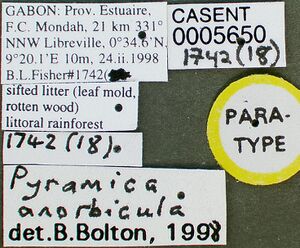Strumigenys anorbicula
| Strumigenys anorbicula | |
|---|---|

| |
| Scientific classification | |
| Kingdom: | Animalia |
| Phylum: | Arthropoda |
| Class: | Insecta |
| Order: | Hymenoptera |
| Family: | Formicidae |
| Subfamily: | Myrmicinae |
| Tribe: | Attini |
| Genus: | Strumigenys |
| Species: | S. anorbicula |
| Binomial name | |
| Strumigenys anorbicula (Bolton, 2000) | |
The type material was collected from sifted litter that consisted of leaf mold and rotten wood in a littoral rainforest.
Identification
Bolton (2000) - A member of the laticeps complex in the Strumigenys argiola group. Immediately diagnosed within the group by its lack of orbicular hairs anywhere on the head and presence of long fine hairs on the anterior clypeal margin, this species is also the only one known that has a transversely arched row of short erect hairs at the highest point of the vertex. See also notes under Strumigenys laticeps.
Keys including this Species
Distribution
Latitudinal Distribution Pattern
Latitudinal Range: 0.56833° to 0.56833°.
| North Temperate |
North Subtropical |
Tropical | South Subtropical |
South Temperate |
- Source: AntMaps
Distribution based on Regional Taxon Lists
Afrotropical Region: Gabon (type locality).
Distribution based on AntMaps
Distribution based on AntWeb specimens
Check data from AntWeb
Countries Occupied
| Number of countries occupied by this species based on AntWiki Regional Taxon Lists. In general, fewer countries occupied indicates a narrower range, while more countries indicates a more widespread species. |

|
Estimated Abundance
| Relative abundance based on number of AntMaps records per species (this species within the purple bar). Fewer records (to the left) indicates a less abundant/encountered species while more records (to the right) indicates more abundant/encountered species. |

|
Biology
|
Castes
Worker
Images from AntWeb
   
| |
| Paratype of Strumigenys anorbicula. Worker. Specimen code casent0005650. Photographer April Nobile, uploaded by California Academy of Sciences. | Owned by CAS, San Francisco, CA, USA. |
   
| |
| Paratype of Strumigenys anorbicula. Worker. Specimen code casent0005651. Photographer April Nobile, uploaded by California Academy of Sciences. | Owned by CAS, San Francisco, CA, USA. |
Queen
Images from AntWeb
   
| |
| Paratype of Strumigenys anorbicula. Queen (alate/dealate). Specimen code casent0005648. Photographer April Nobile, uploaded by California Academy of Sciences. | Owned by CAS, San Francisco, CA, USA. |
Nomenclature
The following information is derived from Barry Bolton's Online Catalogue of the Ants of the World.
- anorbicula. Pyramica anorbicula Bolton, 2000: 287 (w.q.) GABON. Combination in Strumigenys: Baroni Urbani & De Andrade, 2007: 115
Unless otherwise noted the text for the remainder of this section is reported from the publication that includes the original description.
Description
Worker
Holotype. TL 2.2, HL 0.52, HW 0.64, CI 125, ML 0.26, MI 50, SL 0.26, SI 40, PW 0.38, AL 0.56. Apicodorsal tooth of mandible spiniform, much longer than the ventral tooth of the apical series; each apicodorsal tooth projects beyond the outer margin of the opposing mandible at full closure. Mandible with 2 small preapical teeth, located close to the apicodorsal tooth, the proximal preapical slightly longer than the distal. Mandible without large flattened hairs arising from its dorsal surface. Anterior clypeal margin with 6 very long anteriorly directed hairs that are not strap-like. Instead they are broadest basally, where they are somewhat flattened, but distally taper to long finely filiform apices; the longest of them (the outermost) are more than 0.50 X ML. Dorsum of head entirely lacking orbicular hairs. Highest point of vertex with an arched transverse row of short stout erect hairs that are inclined or feebly curved anteriorly. With alitrunk in profile outline of anterior portion of mesonotum slightly depressed, of posterior portion convex and humped.
Paratypes. TL 2.0-2.2, HL 0.48-0.54, HW 0.60-0.66, CI 122-129, ML 0.23-0.26, MI 46-50, SL 0.25-0.28, SI 39-43, PW 0.35-0.40, AL 0.54-0.58 (10 measured).
Type Material
Holotype worker, Gabon: Provo Estuaire, F. C. Mondah, 21 km. 331° NNW Libreville, 0°34.6'N, 9°20.1'E, 10 m., 24.ii.1998, #1742(10), sifted litter (leaf mold, rotten wood), littoral rainforest (B.L. Fisher) (The Natural History Museum).
Paratypes. 22 workers and 1 queen (dealate) with same data as holotype but sample numbers #1742 (2, 4, 6, 12, 13, 14, 15, 18, 44, and 45) (BMNH, Museum of Comparative Zoology, South African Museum, Los Angeles County Museum of Natural History, and in coll. Fisher).
References
- Baroni Urbani, C. & De Andrade, M.L. 2007. The ant tribe Dacetini: limits and constituent genera, with descriptions of new species. Annali del Museo Civico di Storia Naturale “G. Doria”. 99: 1-191.
- Bolton, B. 2000. The ant tribe Dacetini. Memoirs of the American Entomological Institute. 65:1-1028. (page 287, worker described)
References based on Global Ant Biodiversity Informatics
- Bolton, B. 2000. The Ant Tribe Dacetini. Memoirs of the American Entomological Institute 65

